Women and Men in Society
 |
 |
 |
 |
 |
 |
 |
A Brief Guide for Wedding Receptions - I
Setting the Proper Tone of Sacrality
Sometime ago, one of TIA’s readers expressed his sadness at the lack of norms for a truly traditional Catholic wedding reception. He was grieved to have attended a reception of a friend where he saw immodest clothing, improper music and dancing, meager conversation due to the volume of the music, and a complete spontaneity in toasting the couple.
As a young woman preparing for my own upcoming marriage, I was asked to answer those requests and offer some guidelines on what to keep in mind for a traditional Catholic wedding reception.
Motives for marriage
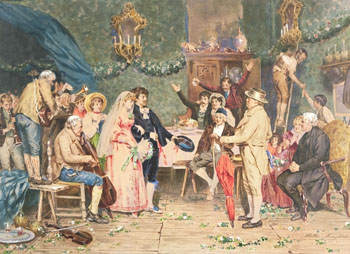 As a Sacrament, marriage has a three-fold purpose according to the Council of Trent: the generation and upbringing of children in the Catholic Faith, mutual support for the spouses in the trials of life and old age, and a remedy for concupiscence. An overarching reason for marriage, as a Sacrament of the Church, is the eternal salvation of the betrothed couple and their progeny.
As a Sacrament, marriage has a three-fold purpose according to the Council of Trent: the generation and upbringing of children in the Catholic Faith, mutual support for the spouses in the trials of life and old age, and a remedy for concupiscence. An overarching reason for marriage, as a Sacrament of the Church, is the eternal salvation of the betrothed couple and their progeny.
A marriage establishes a family which is the basic cell of any organic society. It is also a means for a man and woman to reach the heights of heaven together and to bring their children with them. It is the visible image of Christ's love for His Church and a way to imitate the model given to us by the Holy Family. With these motives, we delve into the proper mindset for approaching this Sacrament.
‘Whom do you say that I am?’
As Catholics, we profess our faith in Holy Mother Church, which Christ instituted through his Apostles. When Our Lord asked "But whom do you say that I am?" (Matt 16:15), we should respond as St. Peter did, confessing "Thou art Christ, the Son of the living God." When we confess Christ as God, we acknowledge our allegiance and desire to conform to Him and His Church. In so doing, our whole lives assume an air of solemnity as we keep the end for which we were created – union with Our Lord in Heaven – always in our sight.
The concept is simple: To prove our love for God, we must keep His commandments (John 14: 15-21). The precepts of the Church, the Sacraments, daily prayer, growth in virtue, the Rosary and Holy Mass must be at the forefront of our quotidian lives. When all of these factors are present, we try to avoid banal trivialities, superfluous worldly pleasures, shallow conversations and other temptations to sin.
Based on these presuppositions, we would attempt to reflect this deference, this great love for the One who created us, at the joyful celebration of a wedding. Our weddings should be a homage to the King of Kings and a testimony for all our friends and family who witness it of our loyalty to our Heavenly King.
Never lose sacrality
We must ask ourselves: How can we apply these principles to a wedding and reception?
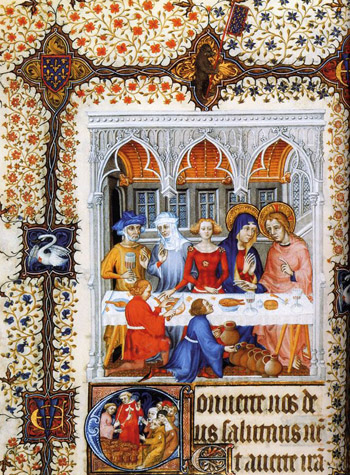 The question of what is a proper Catholic wedding reception finds an answer in Moral Theology. Today there are many who would scoff at the question, deeming something as mundane as a wedding reception a trifling matter that Our Lord would not bother about.
The question of what is a proper Catholic wedding reception finds an answer in Moral Theology. Today there are many who would scoff at the question, deeming something as mundane as a wedding reception a trifling matter that Our Lord would not bother about.
However, Our Lord himself was present at a wedding reception at Cana, where He worked His first miracle, turning water into wine for a couple who were embarrassed because it had run out. (1) Even our "lowly affairs" are His business, as He desires to be Lord of our whole life , not merely a portion of it.
A series of practical suggestions for the betrothed couple's wedding and reception are all based on the principal goal of all our actions, which is to give glory to God. Let the Catholic couple trying to live a holy, virtuous life be firm in this goal: Never let any parent, family member or friend coerce you into making your wedding lose the spirit of sacrality you want it to have. To follow the immodest fashions and spontaneous and extravagant fads of the modern age is not to follow the Catholic customs of the past that sought to please God first rather than man.
Setting the tone for marriage
The wedding sets the tone for the marriage; thus, it should be one of great joy, but also a tone reflecting the seriousness of that union, one that does not revel in trite or vulgar practices. The focus should be on how Almighty God has brought the couple together to fulfill their vocation.
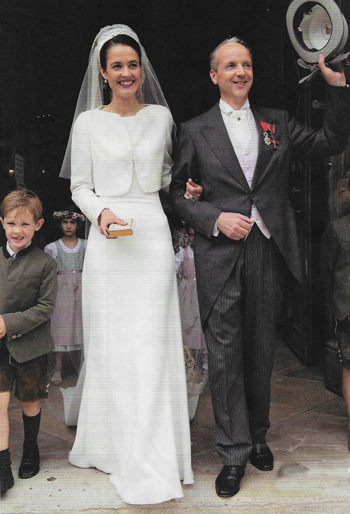 Catholic weddings may differ greatly in their degree of elaborateness or simplicity. Today, however, there is a tendency even in Catholic circles toward extravagance in wedding receptions. Trying to equal or outdo the weddings of worldly friends, a couple can be induced either to spend much more than it can afford or to adopt practices that are really not in accord with the solemnity of the Sacrament. Both tendencies should be avoided.
Catholic weddings may differ greatly in their degree of elaborateness or simplicity. Today, however, there is a tendency even in Catholic circles toward extravagance in wedding receptions. Trying to equal or outdo the weddings of worldly friends, a couple can be induced either to spend much more than it can afford or to adopt practices that are really not in accord with the solemnity of the Sacrament. Both tendencies should be avoided.
The expense in the wedding and reception should reflect the state of life of the couple. It is proper to the virtues of justice and humility to recognize our own financial status and social hierarchy. A couple should not try to appear more than what they are to impress their friends and family; on the other hand, they should not be embarrassed to offer a formal elaborate wedding reception should their circumstances permit it.
In his book Beginning your Marriage, Fr. John Lawrence Thomas, S.J., states: "Although the wedding is both a religious and a social event, it is ridiculous to turn it into a fashion show. You should not attempt to 'show off' by the size and splendor of your wedding reception. It is a healthy thought to reflect that you won't fool anybody, anyway. People know pretty well how much money you have and what you can reasonably afford."
Let your wedding be correct and follow good taste in every detail. The flower arrangements should be graceful and pleasing, the place settings formal or semi-formal, the linens real. Many Catholic couples, trying to offset the secular pattern of the modern wedding, choose to include a special holy card with a patron saint or a religious item such as a rosary as a gift. Some couples feature statues, medals, holy images or other sacramentals in their wedding; others prefer to use symbolism of a religious nature: for example, roses to symbolize Mary, the Mystical Rose; lilies to symbolize the Resurrection, or olives for peace and fertility.
Following this pattern, whether large or small, your reception will be beautiful and memorable.
Modesty in clothing
What is the proper attire of the bride and bridal party? The couple to be wed should be an example of sobriety and chastity for all, especially for the young and unwed Catholic. It used to be superfluous to say that the dress of the bride and her maids of honor should be modest, both for the Church ceremony and the reception.
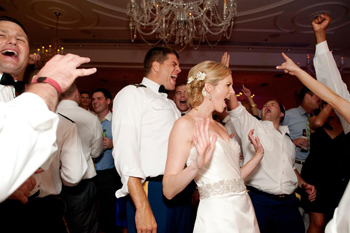
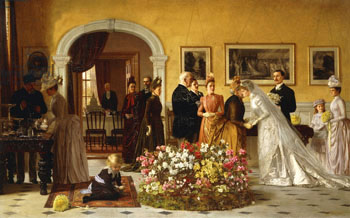 Today, unfortunately, even brides at Catholic weddings choose to "follow the style" and use immodest dresses for themselves and their bridal attendants. This hardly gives glory to God and respects the final ends of the Sacrament.
Today, unfortunately, even brides at Catholic weddings choose to "follow the style" and use immodest dresses for themselves and their bridal attendants. This hardly gives glory to God and respects the final ends of the Sacrament.
The bride, dressed in white as a sign of her virginity, should not show bare skin or present a daring, bold picture of immodesty. Her arms, legs and chest should be covered following the precepts of modesty. (2)
The groom and groomsmen should wear tuxedos or suits, polished leather shoes, and one or more of the following items: a bow tie or tie, cummerbund or vest and pocket square. Even if there are non-Catholic attendees, the wedding guests must be urged to observe the same rules of modesty out of respect principally for Our Lord and also for the couple and all the Catholics present. It is appropriate to include a gentle reminder to wear modest clothing in the wedding invitations so as to avoid embarrassment and scandal.
It is courteous for female guests not to wear white, as this is the bride's color, and to avoid an extravagance in colors and fashions that aim to "outdo" the bride and focus attention on themselves.
Continued

Posted November 1, 2017
As a young woman preparing for my own upcoming marriage, I was asked to answer those requests and offer some guidelines on what to keep in mind for a traditional Catholic wedding reception.
Motives for marriage

A simple reception for newlyweds in days past
A marriage establishes a family which is the basic cell of any organic society. It is also a means for a man and woman to reach the heights of heaven together and to bring their children with them. It is the visible image of Christ's love for His Church and a way to imitate the model given to us by the Holy Family. With these motives, we delve into the proper mindset for approaching this Sacrament.
‘Whom do you say that I am?’
As Catholics, we profess our faith in Holy Mother Church, which Christ instituted through his Apostles. When Our Lord asked "But whom do you say that I am?" (Matt 16:15), we should respond as St. Peter did, confessing "Thou art Christ, the Son of the living God." When we confess Christ as God, we acknowledge our allegiance and desire to conform to Him and His Church. In so doing, our whole lives assume an air of solemnity as we keep the end for which we were created – union with Our Lord in Heaven – always in our sight.
The concept is simple: To prove our love for God, we must keep His commandments (John 14: 15-21). The precepts of the Church, the Sacraments, daily prayer, growth in virtue, the Rosary and Holy Mass must be at the forefront of our quotidian lives. When all of these factors are present, we try to avoid banal trivialities, superfluous worldly pleasures, shallow conversations and other temptations to sin.
Based on these presuppositions, we would attempt to reflect this deference, this great love for the One who created us, at the joyful celebration of a wedding. Our weddings should be a homage to the King of Kings and a testimony for all our friends and family who witness it of our loyalty to our Heavenly King.
Never lose sacrality
We must ask ourselves: How can we apply these principles to a wedding and reception?

Our Lady appeals to her Son to assist embarrassed newlyweds at their reception
However, Our Lord himself was present at a wedding reception at Cana, where He worked His first miracle, turning water into wine for a couple who were embarrassed because it had run out. (1) Even our "lowly affairs" are His business, as He desires to be Lord of our whole life , not merely a portion of it.
A series of practical suggestions for the betrothed couple's wedding and reception are all based on the principal goal of all our actions, which is to give glory to God. Let the Catholic couple trying to live a holy, virtuous life be firm in this goal: Never let any parent, family member or friend coerce you into making your wedding lose the spirit of sacrality you want it to have. To follow the immodest fashions and spontaneous and extravagant fads of the modern age is not to follow the Catholic customs of the past that sought to please God first rather than man.
Setting the tone for marriage
The wedding sets the tone for the marriage; thus, it should be one of great joy, but also a tone reflecting the seriousness of that union, one that does not revel in trite or vulgar practices. The focus should be on how Almighty God has brought the couple together to fulfill their vocation.

Magdalena de Tornos and Count Jean d'Haussonville greet guests at their reception in Vienna
The expense in the wedding and reception should reflect the state of life of the couple. It is proper to the virtues of justice and humility to recognize our own financial status and social hierarchy. A couple should not try to appear more than what they are to impress their friends and family; on the other hand, they should not be embarrassed to offer a formal elaborate wedding reception should their circumstances permit it.
In his book Beginning your Marriage, Fr. John Lawrence Thomas, S.J., states: "Although the wedding is both a religious and a social event, it is ridiculous to turn it into a fashion show. You should not attempt to 'show off' by the size and splendor of your wedding reception. It is a healthy thought to reflect that you won't fool anybody, anyway. People know pretty well how much money you have and what you can reasonably afford."
Let your wedding be correct and follow good taste in every detail. The flower arrangements should be graceful and pleasing, the place settings formal or semi-formal, the linens real. Many Catholic couples, trying to offset the secular pattern of the modern wedding, choose to include a special holy card with a patron saint or a religious item such as a rosary as a gift. Some couples feature statues, medals, holy images or other sacramentals in their wedding; others prefer to use symbolism of a religious nature: for example, roses to symbolize Mary, the Mystical Rose; lilies to symbolize the Resurrection, or olives for peace and fertility.
Following this pattern, whether large or small, your reception will be beautiful and memorable.
Modesty in clothing
What is the proper attire of the bride and bridal party? The couple to be wed should be an example of sobriety and chastity for all, especially for the young and unwed Catholic. It used to be superfluous to say that the dress of the bride and her maids of honor should be modest, both for the Church ceremony and the reception.

Above, inappropriate attire and tone; below, a joyful home reception with proper decorum

The bride, dressed in white as a sign of her virginity, should not show bare skin or present a daring, bold picture of immodesty. Her arms, legs and chest should be covered following the precepts of modesty. (2)
The groom and groomsmen should wear tuxedos or suits, polished leather shoes, and one or more of the following items: a bow tie or tie, cummerbund or vest and pocket square. Even if there are non-Catholic attendees, the wedding guests must be urged to observe the same rules of modesty out of respect principally for Our Lord and also for the couple and all the Catholics present. It is appropriate to include a gentle reminder to wear modest clothing in the wedding invitations so as to avoid embarrassment and scandal.
It is courteous for female guests not to wear white, as this is the bride's color, and to avoid an extravagance in colors and fashions that aim to "outdo" the bride and focus attention on themselves.
Continued
- Jn 2:3 "And the wine failing, the mother of Jesus saith to him: They have no wine." It is important to note that Our Lady explicitly said this to help the couple, entreating Our Lord to intervene.
- The Cardinal Vicar of Pius XI, Donato Sbaretti, Prefect of the Congregation of the Council, on the Feast of the Holy Family (January 12, 1930) issued the following rule as to what constitutes modesty in dress: "A dress cannot be called decent which is cut deeper than two fingers breadth under the pit of the throat, which does not cover the arms at least to the elbows; and scarcely reaches a bit beyond the knees. Furthermore, dresses of transparent material are improper" (Imprimatur dSept. 24, 1956).

Posted November 1, 2017
______________________
______________________








